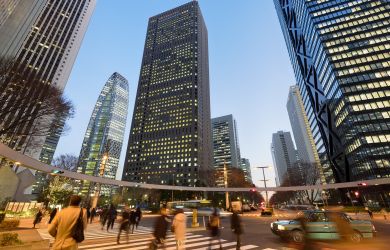
Originally published on metropolis.co.jp on September 2011

What brought you to Japan and how long have you been here?
I first came in 2008, when my husband and I came on a couple weeks’ holiday from where we were living in Madagascar. Soon after there was a coup d’état in Madagascar—we had to leave, and to make along story short, we ended up in Japan. [Around that time… ] I met Geeta [Mehta, New Japan Architecture co-author] and we started working together on this book—so my connection with Japan developed out of a coup in Madagascar… And in that time I fell in love with Japan, as people do, and about a year later my husband and I moved here full-time.
How did New Japan Architecture come about?
My co-author, Geeta Mehta, has a long history with Tuttle. She’s an architect and an architectural historian, and she lived in Japan for 23 years . She’s done a few other books on Japan with them. Tuttle published New China Architecture, and so they approached Geeta about one on Japan. I called her up to do an interview about Frank Lloyd Wright’s buildings in Japan. After [we got to know each other] she said, “I have this book project—do you want to come on board?” That was in early 2009. So we put our heads down and began researching the buildings.
What is your favorite architectural design in Tokyo?
I’m an architectural historian by training, so I am interested in history and I like buildings that are very contemporary but that play with tradition. I really like Kengo Kuma’s work because he does just that; takes the traditions of Japanese architecture and makes them completely modern. He recently did the Nezu Museum, which is a beautiful update of a traditional Japanese style: pitched roofs and beautiful clear, simple spaces that perfectly frame the art works. The design also incorporates the Nezu’s famous gardens—Japanese architecture often uses “borrowed landscapes,” framing exterior views in such a way as to make them part of the interior experience. The museum’s design is a beautiful example of both traditional and contemporary Japan architecture in one building.
What defines the architectural landscape of Tokyo?
It’s mad visual chaos with little pockets of quiet beauty.
What is one building that readers should really get out and see in the city? Outside the city?
An easy place to go and see a lot of really interesting recent buildings is just to walk up Omotesando, starting at the Nezu Museum at the bottom and working your way up. You go by the Prada building by Herzog & de Meuron, Toyo Ito’s TOD’s building (which very cleverly uses poured cement to evoke zelkova trees), and Tadeo Ando’s Omotesando Hills. There’s also MVDRV’s shadowy Gyre building, and near the crossing by the Meiji-jingue Metro, there’s a new building going up by NAP Architects that’s going to have a living roof complete with full-grown trees—an example of growing interest in “green” architecture. Omotesando is an easy place to go and see a lot of exciting new architecture. Outside of Tokyo—there’s a lot. One I really like, by Kengo Kuma, which is classically Japanese really, is the Ginza Onsen Fujiya. It’s up north in Yamagata. It’s a gorgeous renovation of a traditional onsen.
The other feature in our magazine is on the Metabolist exhibit at the Mori. Are you a fan of Metabolism?
I am, I am, but with reservations. Certainly, historically it’s really important—it was part of the zeitgeist at that point. It was really important to create something that was modern, new, that looked to the future and never looked back. It was something that had to happen at the time. The things they came up with, like the Nakagin Capsule Tower, are just amazing. But it in many ways the movement was ahead of its time; for example, their ideas were often far ahead of the technology available. And sometimes you need to remember your history, to know what has worked and what hasn’t.
How do you feel about the fate of the Nagakin Capsule Tower in Shimbashi?
I’m of two minds because traditionally I’ve always been very pro-preservation of historic buildings: if the building’s history has architectural value or even beauty, I’m for saving it. But since I’ve come to Japan, where ideas of preservation and authenticity are more ephemeral—they’re built, used, rebuilt or disappear—I’ve started to see that the whole Heritage Organization-type of preservation is not ideal in all circumstances. If a developer was interested in turning the Capsule Tower into something like a stylish, modernist hotel (if you could find an investor—from what I understand there are none interested) that would be great. Or they could do exactly what Kurokawa designed it for: move it and reassemble it somewhere else where it can be used and preserved. But as it is, the building is really in bad shape. With real estate values in Tokyo, the plan is always just to knock buildings down and build something more profitable.
Who are some of your favorite Japanese architects or design firms?
I love Kengo Kuma. I like what he does, because he has a great respect for traditional Japanese architecture, but you would never call his work “old fashioned.” Whether it’s a hotel, or a museum, or a personal home—he makes beautiful things. There are lots of interesting younger architects who are looking for more sustainable architectures: NAP Architects, Endo Shuhei, Tezuka Architects, and there’s Atelier Tekuto. Young people like Sou Fujimoto and Junya Ishigami are exploring new ways of using Japan’s architectural traditions today and trying to make Japan a more beautiful country. Oh, and Terunobu Fujimori, he’s a professor and architectural historian, and he makes the most fascinating buildings (like the “Too High Tea House” that is built on top of two trees). He takes tradition and craftsmanship and brings them together in the most whimsical way, provoking so much conversation about architecture and what it can be. He’s completely unique.
See our feature for some exclusive extracts from New Japan Architecture.
To hear the complete interview visit http://meturl.com/deannamac





